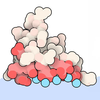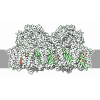+ Open data
Open data
- Basic information
Basic information
| Entry | Database: PDB / ID: 6wz2 | |||||||||
|---|---|---|---|---|---|---|---|---|---|---|
| Title | Co-bound structure of an engineered protein trimer, TriCyt3 | |||||||||
 Components Components | Soluble cytochrome b562 | |||||||||
 Keywords Keywords | METAL BINDING PROTEIN / four-helix bundle / metalloprotein trimer | |||||||||
| Function / homology |  Function and homology information Function and homology informationelectron transport chain / periplasmic space / electron transfer activity / iron ion binding / heme binding Similarity search - Function | |||||||||
| Biological species |  | |||||||||
| Method |  X-RAY DIFFRACTION / X-RAY DIFFRACTION /  SYNCHROTRON / SYNCHROTRON /  MOLECULAR REPLACEMENT / Resolution: 2.0006 Å MOLECULAR REPLACEMENT / Resolution: 2.0006 Å | |||||||||
 Authors Authors | Tezcan, F.A. / Kakkis, A. | |||||||||
| Funding support |  United States, 2items United States, 2items
| |||||||||
 Citation Citation |  Journal: Angew.Chem.Int.Ed.Engl. / Year: 2020 Journal: Angew.Chem.Int.Ed.Engl. / Year: 2020Title: Metal-Templated Design of Chemically Switchable Protein Assemblies with High-Affinity Coordination Sites. Authors: Kakkis, A. / Gagnon, D. / Esselborn, J. / Britt, R.D. / Tezcan, F.A. | |||||||||
| History |
|
- Structure visualization
Structure visualization
| Structure viewer | Molecule:  Molmil Molmil Jmol/JSmol Jmol/JSmol |
|---|
- Downloads & links
Downloads & links
- Download
Download
| PDBx/mmCIF format |  6wz2.cif.gz 6wz2.cif.gz | 85.3 KB | Display |  PDBx/mmCIF format PDBx/mmCIF format |
|---|---|---|---|---|
| PDB format |  pdb6wz2.ent.gz pdb6wz2.ent.gz | 63.4 KB | Display |  PDB format PDB format |
| PDBx/mmJSON format |  6wz2.json.gz 6wz2.json.gz | Tree view |  PDBx/mmJSON format PDBx/mmJSON format | |
| Others |  Other downloads Other downloads |
-Validation report
| Summary document |  6wz2_validation.pdf.gz 6wz2_validation.pdf.gz | 1.9 MB | Display |  wwPDB validaton report wwPDB validaton report |
|---|---|---|---|---|
| Full document |  6wz2_full_validation.pdf.gz 6wz2_full_validation.pdf.gz | 1.9 MB | Display | |
| Data in XML |  6wz2_validation.xml.gz 6wz2_validation.xml.gz | 17.6 KB | Display | |
| Data in CIF |  6wz2_validation.cif.gz 6wz2_validation.cif.gz | 24.1 KB | Display | |
| Arichive directory |  https://data.pdbj.org/pub/pdb/validation_reports/wz/6wz2 https://data.pdbj.org/pub/pdb/validation_reports/wz/6wz2 ftp://data.pdbj.org/pub/pdb/validation_reports/wz/6wz2 ftp://data.pdbj.org/pub/pdb/validation_reports/wz/6wz2 | HTTPS FTP |
-Related structure data
| Related structure data |  6wyuC 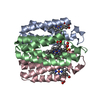 6wz0C  6wz1C 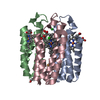 6wz3C 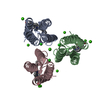 6wz7C 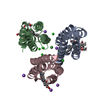 6wzaC  6wzcC 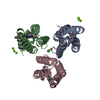 6x7eC 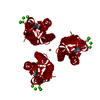 6x8xC 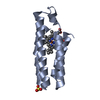 2bc5S S: Starting model for refinement C: citing same article ( |
|---|---|
| Similar structure data |
- Links
Links
- Assembly
Assembly
| Deposited unit | 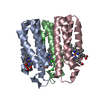
| ||||||||
|---|---|---|---|---|---|---|---|---|---|
| 1 |
| ||||||||
| Unit cell |
|
- Components
Components
| #1: Protein | Mass: 11796.407 Da / Num. of mol.: 3 Mutation: T31K, A35K, Q41K, D54A, K59I, H63V, I67E, V69A, G70W, Q71E, D73H, L76A, K77H, N80K, R98C, Y101C Source method: isolated from a genetically manipulated source Source: (gene. exp.)   #2: Chemical | #3: Chemical | ChemComp-CO / | #4: Chemical | ChemComp-CL / #5: Water | ChemComp-HOH / | Has ligand of interest | Y | Has protein modification | Y | |
|---|
-Experimental details
-Experiment
| Experiment | Method:  X-RAY DIFFRACTION / Number of used crystals: 1 X-RAY DIFFRACTION / Number of used crystals: 1 |
|---|
- Sample preparation
Sample preparation
| Crystal | Density Matthews: 2.48 Å3/Da / Density % sol: 50.46 % |
|---|---|
| Crystal grow | Temperature: 298 K / Method: vapor diffusion, sitting drop / pH: 7.5 / Details: 25% PEG1500, 0.2 M MgCl2, 0.1 M HEPES (pH 7.5) |
-Data collection
| Diffraction | Mean temperature: 100 K / Serial crystal experiment: N |
|---|---|
| Diffraction source | Source:  SYNCHROTRON / Site: SYNCHROTRON / Site:  SSRL SSRL  / Beamline: BL12-2 / Wavelength: 1.2398 Å / Beamline: BL12-2 / Wavelength: 1.2398 Å |
| Detector | Type: DECTRIS PILATUS 6M / Detector: PIXEL / Date: Mar 9, 2020 |
| Radiation | Protocol: SINGLE WAVELENGTH / Monochromatic (M) / Laue (L): M / Scattering type: x-ray |
| Radiation wavelength | Wavelength: 1.2398 Å / Relative weight: 1 |
| Reflection | Resolution: 2.0006→35.0477 Å / Num. obs: 23044 / % possible obs: 96.62 % / Redundancy: 6.7 % / CC1/2: 0.999 / Rmerge(I) obs: 0.0596 / Rpim(I) all: 0.02456 / Rrim(I) all: 0.06459 / Net I/σ(I): 20.34 |
| Reflection shell | Resolution: 2.001→2.073 Å / Rmerge(I) obs: 0.4254 / Mean I/σ(I) obs: 3.64 / Num. unique obs: 1947 / CC1/2: 0.926 / Rpim(I) all: 0.1891 / Rrim(I) all: 0.4669 |
- Processing
Processing
| Software |
| |||||||||||||||||||||||||||||||||||||||||||||||||||||||||||||||||||||||||||||||||||||||||||||||||||||||||
|---|---|---|---|---|---|---|---|---|---|---|---|---|---|---|---|---|---|---|---|---|---|---|---|---|---|---|---|---|---|---|---|---|---|---|---|---|---|---|---|---|---|---|---|---|---|---|---|---|---|---|---|---|---|---|---|---|---|---|---|---|---|---|---|---|---|---|---|---|---|---|---|---|---|---|---|---|---|---|---|---|---|---|---|---|---|---|---|---|---|---|---|---|---|---|---|---|---|---|---|---|---|---|---|---|---|---|
| Refinement | Method to determine structure:  MOLECULAR REPLACEMENT MOLECULAR REPLACEMENTStarting model: 2bc5 Resolution: 2.0006→35.0477 Å / SU ML: 0.2 / Cross valid method: THROUGHOUT / σ(F): 1.35 / Phase error: 21.34 / Stereochemistry target values: ML
| |||||||||||||||||||||||||||||||||||||||||||||||||||||||||||||||||||||||||||||||||||||||||||||||||||||||||
| Solvent computation | Shrinkage radii: 0.9 Å / VDW probe radii: 1.11 Å / Solvent model: FLAT BULK SOLVENT MODEL | |||||||||||||||||||||||||||||||||||||||||||||||||||||||||||||||||||||||||||||||||||||||||||||||||||||||||
| Refinement step | Cycle: LAST / Resolution: 2.0006→35.0477 Å
| |||||||||||||||||||||||||||||||||||||||||||||||||||||||||||||||||||||||||||||||||||||||||||||||||||||||||
| Refine LS restraints |
| |||||||||||||||||||||||||||||||||||||||||||||||||||||||||||||||||||||||||||||||||||||||||||||||||||||||||
| LS refinement shell |
|
 Movie
Movie Controller
Controller





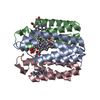


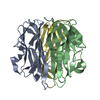
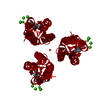
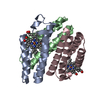


 PDBj
PDBj










